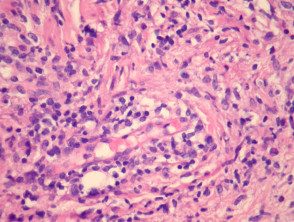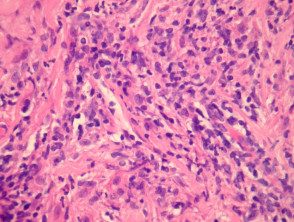Introduction
Extranodal NK /T cell lymphoma, nasal type, is a disease driven by the Epstein-Barr virus (EBV) that generally affects mainly the upper respiratory tract (see Associated with the Epstein-Barr virus lymphoproliferative disorders). The skin is secondarily involved, but a primarily skin-based disease can also occur.
Histology extranodal NK / T cell lymphoma, nasal type
In extranodal NK / T cell lymphoma, nasal type, there is a density dermal infiltrate (figure 1) which often extends into the subcutis. Exocytosis of atypical lymphocytes at epidermis can be seen and can look very much like mycosis fungoides (Figure 2). The infiltrator in the dermis It is usually polymorphous and can include numerous histiocytes and eosinophils. Atypical cells are small to medium in size with some larger shapes (Figures 3, 4). Commonly, the insider infiltrators Vessel walls (Figures 3, 4) cause vascular. Nuclear debris (seen focally in figure 4) and necrosis It is another common finding.
Extranodal NK / T cell lymphoma, nasal-like pathology

Figure 1

Figure 2

figure 3

Figure 4
Special studies for extranodal NK / T cell lymphoma, nasal type
The special spots are essential to make the diagnosis. In the place Hybridization with EBV shows that the atypical cells are positive. Atypical cells are generally positive with immunohistochemistry for CD56 and granzyme or TIA1. Some cases will express the T cell CD3 marker. T cell gene Reorganization studies are often negative.
Differential diagnosis extranodal NK / T cell lymphoma, nasal type
Other peripheral T-cell lymphomas and subcutaneous panniculitis-how T-cell lymphoma can look like this lymphoma. Positive T-cell gene rearrangement studies and positive T-cell immunohistochemical studies would favor T-cell lymphoma. Expression of EBV, CD56, and granzyme are unusual findings in other T-cell lymphomas.

